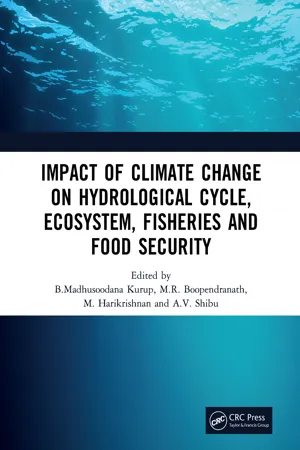
Impact of Climate Change on Hydrological Cycle, Ecosystem, Fisheries and Food Security
- 566 pages
- English
- ePUB (mobile friendly)
- Available on iOS & Android
Impact of Climate Change on Hydrological Cycle, Ecosystem, Fisheries and Food Security
About this book
Climate change has emerged as the most pressing global challenge of the 21st century and it has a dramatic effect on natural ecosystems and environment. Intelligent mitigation strategies to minimise climate change impacts can result in advanced, novel technologies; healthier aquatic ecosystems and higher food security and well-being for humans. The book includes 45 Chapters by expert authors, covering (i) Hydrometeorology and hydrology, (ii) Natural hazards and disaster risk management, (iii) Aquaculture, (iv) Changing biodiversity scenarios, (v) Capture fisheries, (vi) Food and nutritional insecurity, (vii) Climate change and socio-economic scenarios, and allied areas. It is hoped that this volume will further our understanding and research achievements in the field of climate change and its consequences and facilitate the synthesis of information on how climate-related changes will influence oceans, marine and inland ecosystems, hydrological cycles, fisheries and aquaculture and coastal communities and will be immensely useful to planners, scientists, conservationists, environmentalists, academicians, students and all those who are directly or indirectly involved in the study of impact of climate change and mitigation measures
Note: T& F does not sell or distribute the Hardback in India, Pakistan, Nepal, Bhutan, Bangladesh and Sri Lanka.
Frequently asked questions
- Essential is ideal for learners and professionals who enjoy exploring a wide range of subjects. Access the Essential Library with 800,000+ trusted titles and best-sellers across business, personal growth, and the humanities. Includes unlimited reading time and Standard Read Aloud voice.
- Complete: Perfect for advanced learners and researchers needing full, unrestricted access. Unlock 1.4M+ books across hundreds of subjects, including academic and specialized titles. The Complete Plan also includes advanced features like Premium Read Aloud and Research Assistant.
Please note we cannot support devices running on iOS 13 and Android 7 or earlier. Learn more about using the app.
Information
V Changing Biodiversity Scenarios
CHAPTER - 25 250 Years of Marine Biodiversity Scenarios in India What Will Persist?
Material and Methods
Results and Discussion
| SI. No. | Taxonomic Group | Period | Survey Region | Habitat | Institutions involved | Remarks |
|---|---|---|---|---|---|---|
| 1. | Micro algae (Diatom) | 1930- till date | East and west coasts, Madras Coast | Coastal and Offshore waters | University of Madras Andhra University, BSI, Annamalai University | Studies going on till today. |
| 2. | Macro Algae (Seaweeds) | 1940- till date | East and west coasts, Andaman and Nicobar Islands (A&N). | Intertidal rocky shore of west and east coasts, Coral reef areas in GOMBR, GOK, and A&N islands | BSI, FSI, ZSI, NIO, CSMCRI, CMFRI , NCSCM | Studies going on till today. Large amount of harvesting going on for commercial purposes. |
| 3. | Sea | 1980 — till date | Gulf of Mannar (GOM), Andaman and Nicobar (A&N) Islands and Gulf of Kachchh (GOK). | Near shore area | Botanical Survey of India, Annmalai University, NCSCM | Studies incomplete. And going on till today. Associated fauna not worked out |
| 4. | Mangroves | 1980 — till date | East and west coasts, Sunderbans and Andaman and Nicobar Islands | Littoral Forest | BSI, FSI, ZSINIO, Annamalai University, MSSRF, NCSCM | Studies going on till today. Associated fauna is still to be done. Conservation efforts are on. |
| 5. | Foraminifera | 1798- till date | East and west coasts, Andaman and Nicobar Islands, Lakshadweep | Benthic and pelagic | Indian museum, GSI, ZSI, I ISc, Agarkar Institute | National Institute of Oceanography and a very few universities studying. Very little study conducted and very few scientists working |
| 6. | Porifera (Sponges) | 1894 - till date | East and west coasts, Andaman and Nicobar Islands | Intertidal, coral reef areas | Indian Museum, ZSI, CMFRI. | Very few scientists working. |
| 7. | Cnidaria (All groups) | 1... |
Table of contents
- Cover Page
- Half-Title Page
- Title Page
- Copyright Page
- Table of Contents
- Foreword
- Preface
- Acknowledgments
- I: Hydrometeorology and Hydrology
- II: Natural Hazards and Disaster Risk Management
- III: Aquaculture
- IV: Capture Fisheries
- V" Changing Biodiversity Scenarios
- VI: Food and Nutritional Insecurity
- VII: Climate Change and Socio-Economic Scenarios
- Author Index
- Subject Index